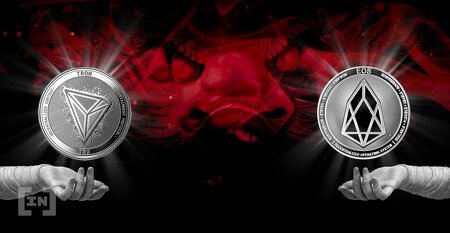
Defi applications on ETH touched a milestone on February 6, when the total value locked (TVL) surpassed $1 billion. Ethereum also boasts a total transaction value of $12.8 billion, more than both EOS and Tron combined. Although the title of second most popular decentralised application network is more hotly contested than ever, Ethereum still dominates the wider ecosystem.
Initiatives are currently being worked on to solve these issues including the ability for smart contracts/dApps to pay for its users transactions on a per call basis. Both platforms utilise a staking model for allocating resources with Tron offering approximately 25 free transactions per day and EOS offering 10x the staked resources when not in congestion mode.
To achieve this scalability, EOS also relies on a Delegated Proof-of-Stake mechanism in order to confirm its transactions where 21 elected Block Producers actively maintain and build the network. EOS has slightly more dApps than Tron with 665, but the project’s user base is smaller with only around 730,000 daily users. However, EOS’s network value exceeds that of Tron with a total daily volume of around $6 billion.
Blockchains EOS and TRON have also solidified themselves as competitors to Ethereum ETH this year. Together, they make up 74 percent of the top 100 dapps ranked by daily user count, according to DappRadar data reviewed by Hard Fork on May 21. In fact, TRON dapps attracted more active users than any other network over the past three months, reports Dapp.com with new research. While choosing the correct dapp platform, there is a trade off involved.
The report released at the end of June shows that EOS has around 500 different dApps of which 200 are active. Ethereum has 2,500 dApps with 300 active decentralized applications. The goal is to be able to scale, remain decentralized and have a different approach to governing a blockchain network. Compared to Bitcoin (BTC) and Ethereum, EOS is much more efficient in the way it processes transactions despite being more centralized than these two networks.
As the longest running smart contract network, Ethereum continues to hold number one spot in terms of both number of active applications and volume of transactions associated with Dapps. However, Tron is proving increasingly popular with developers and, for the first time ever, actually just surpassed EOS in terms of the number of active applications on the network. EOS network, long dubbed as the “Ethereum killer,” is not completely decentralized.
The network was able to reach that position by offering companies, investors and individuals the possibility to deploy dApps on top of the EOS blockchain. While most of the top dapps run on EOS and TRON, a majority of those platforms are online casinos that offer blackjack, roulette, and other games of chance powered by cryptocurrency.

It has 21 validators or ‘Witnesses’ who verify the transactions (Delegated Proof of Stake consensus algorithm). These are either the voted members or the ones with stake (depending on the currency they own). These witnesses are paid for voting and hence securing the network. This has obvious advantages because scalability is no longer an energy guzzling long drawn process. Dapps will be able to onboard users at a much faster speed, and users will not be hostage to network congestions common on Ethereum.
Crypto OPSEC : Accounts, Cell Phones, 2FA & Security
Despite the EOS troubles, the network still saw greater transaction volume than Tron. Users spent around $2.68 billion more on EOS Dapps than on their Tron-based counterparts. Ethereum, the second-largest blockchain by market cap, is leading the twofold growth, according to a report published by Dapp.com.
The developer needs to prioritize what is more important, security or scalability, while choosing the optimum platform. But, it is safe to say that Ethereum is not the run-away leader as it seemed to be in early 2018. EOS and TRON are giving it a tough fight, especially with gaming and gambling apps. Similarly, different regions will see different networks being favored.
TRON
The portal noted that the project attracted the maximum number of daily active users – around 1.42 million – of the total reported. Like TRON, EOS stresses that it is a platform for decentralized applications that is scalable and usable in the real world, unlike Ethereum, which is way too slow.
- registered 65,000 daily active users (DAU), followed by Ethereum with 19,000 DAU and Tron with 15,000 DAU.
- This shows that dApp developers embraced the attempts to build on top of a network capable of building fast and secure decentralized applications.
In return, they give up centralization, and if the nodes gang up, then the underlying platform is at their mercy. These network difficulties seem a likely cause for the sudden change of fortunes that has resulted in Tron not only hosting more applications, but also more active users.
At 668 new additions, it saw more fresh applications built in 2019 than are currently active on either Tron or EOS. Tron, on the other hand, managed to nab the second spot in terms of the number of dapps and active users. Nevertheless, Justin Sun’s blockchain project faced criticism for hosting high-risk apps, creating uncertainty about the growth of its native token TRX.
While the ETH network is older than TRX, they both have similar goals and do similar things. As Ethereum strives to be a “world computer,” Tron aims to accomplish this feat as well, but with more of a focus on entertainment. They both leverage concepts like decentralized finance (defi), decentralized apps (dapps) and permissionless systems for token creation (ERC20 & TRC20). Decentralized app aggregator DappReview summarized the main events within the DApp ecosystem in 2019.
registered 65,000 daily active users (DAU), followed by Ethereum with 19,000 DAU and Tron with 15,000 DAU. This shows that dApp developers embraced the attempts to build on top of a network capable of building fast and secure decentralized applications.
Resource allocation is key in determining the level of friction required to build and interact with a decentralised application. This is an area where EOS has room for improvement as the on-ramps for a new user are not yet seamless.
US and Europe will prefer Ethereum because of privacy concerns whereas Asia will prefer semi-decentralized networks due to their low costs and scalability. Governments in Asia are usually more authoritarian than their western counterparts. These countries would prefer to have a structure that is more “governable” as compared to the freewheeling Ethereum. Hence, they are encouraging EOS and TRON, and discouraging more decentralized platforms like Ethereum.
Ethereum is mainly criticized by EOS and TRON and many other dapp platforms for using far inferior technology in terms of scalability, which is the capacity to handle increasing amounts of work. In the blockchain world, scalability usually means its ability to accommodate more users and more transactions per second. EtherumAfter Bitcoin, it is the most valuable blockchain project by market capitalization and the most well-known to the general public. It is one of the first major blockchain networks built specifically for decentralized applications. Because of its name recognition and relatively long history, Ethereum sets the benchmark for new platforms.
The DeFi sector had a particularly explosive 2019, as noted by cryptocurrency analyst CryptoWolf (@IamCryptoWolf) in the following tweet. However, with the sector still relatively small, one killer application on either network could see this happen in 2020. With a total of 637 active Dapps now supported, Tron has overtaken fellow smart contract platform EOS for the first time ever. The news will be a blow for the EOS ecosystem, which will lose one of its most popular dApps.
The game had previously been topped rankings in terms of daily active users and transaction volumes both for this year and the last, according to dApps statistics site DappRadar. The DPoS was developed by Dan Larimer in order to offer a better efficiency to his blockchain project BitShares, which is now being applied on EOS and Steem. Active users in the DPoS network vote for “witnesses” and “delegates” by placing their tokens on the name of their candidate. Both BitShares and Steemit became popular blockchain networks in the market, but EOS was able to reach and remain among the top 10 largest cryptocurrencies for a long period of time.
This same scenario played out in Baidu vs. Google, and other similar internet companies that were encouraged and supported because they were willing to follow local rules. When Novak tweeted about moving TRX to the Liquid network, lots of people considered it a joke, while others took the tweet very seriously. We want to let our readers decide which project is better by weighing the pros and cons of each crypto without all the opinions. One could consider the crypto networks Tron (TRX) and Ethereum (ETH) competitors within the cryptoconomy.
Even worse, 90 percent of TRON dapp transactions during the last quarter were directly related to cryptocurrency gambling. Earlier this year, cryptocurrency gamblers (and their dapps) left the Ethereum blockchain en masse for Delegated Proof-of-Stake systems like EOS and TRON. Ethereum has far more weight in tether USDT with 2.2 billion issued on the ERC20 standard. Tron has been gathering USDT as well but only has 814 million tethers on the network.
EOS vs Ethereum vs TRON – Which Is Best? In-Depth Review
ETH also has stablecoins like TUSD, USDC, and PAX.As far as stablecoin usage is concerned, Ethereum outpaces Tron by a long shot, as the chain also has other stablecoin tokens like PAX, USDC, and TUSD. But it’s true that both networks have seen more tethers migrate to each blockchain during certain periods of 2019.


